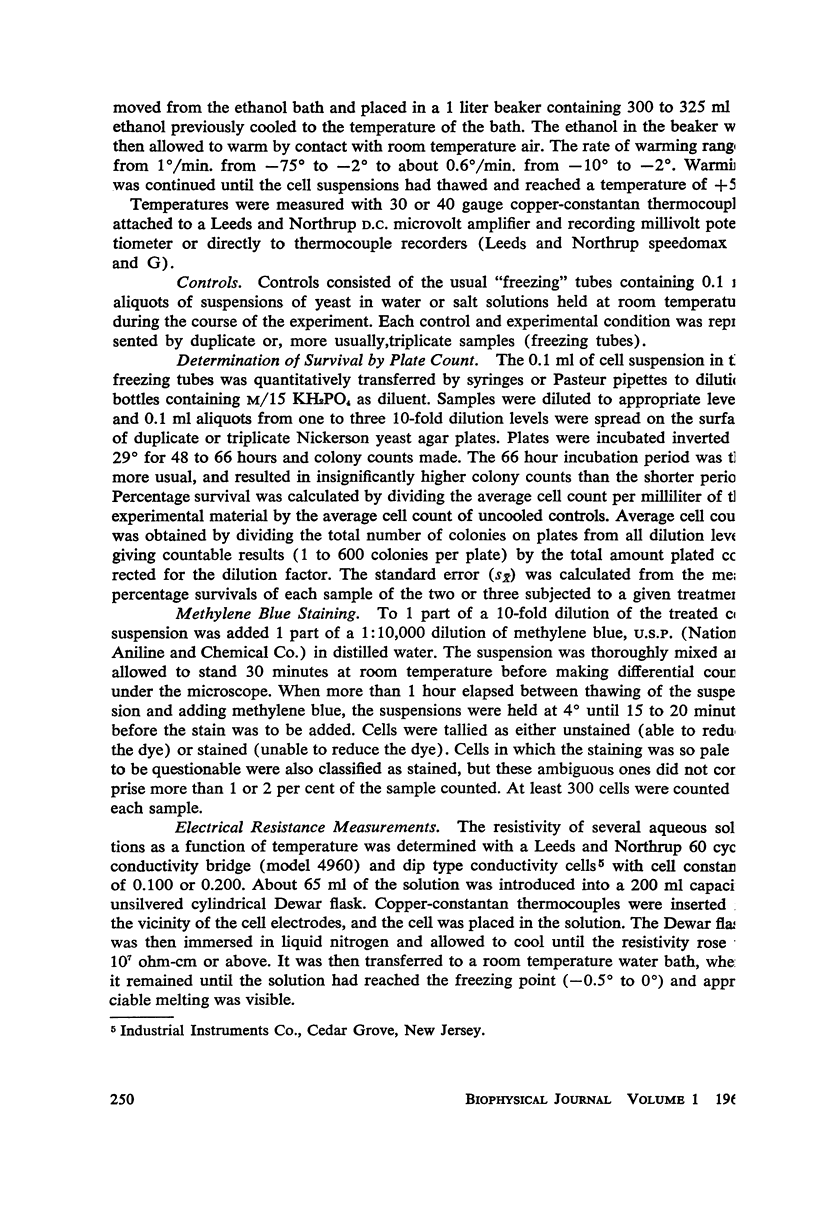Abstract
The survival of yeast cells after exposure to subzero temperatures was affected by the cooling and warming velocity, temperature itself, and the physical state of the water surrounding the cells. The cells were injured only when the external medium was frozen and then only when the temperature was -10° or below. Survival dropped abruptly between -10° and -30° regardless of whether the cells were suspended in water or 0.1 M solutions of KH2PO4, NaC1, or CaC12. The critical temperature range of -10° to -30° was unrelated to the temperatures at which the suspending fluids completely solidified, these temperatures being -0.3°, -11°, -30°, and -71° for the four liquids, respectively. Survival at -30° or below was greatly affected by the rate at which the cells were cooled or warmed, with higher survivals being obtained with slow cooling and with rapid warming. Length of exposure at -30° was not a factor; injury was inflicted within 1 minute. The results are interpreted as indicating that death is a result of intracellular ice formation. Internal freezing is believed to occur when external ice crystals grow through aqueous channels in the cell wall or membrane and seed supercooled water in the cell interior.
Full text
PDF

















Selected References
These references are in PubMed. This may not be the complete list of references from this article.
- CONWAY E. J., DUGGAN F. A cation carrier in the yeast cell wall. Biochem J. 1958 Jun;69(2):265–274. doi: 10.1042/bj0690265. [DOI] [PMC free article] [PubMed] [Google Scholar]
- FERNANDEZ-MORAN H. Low-temperature preparation techniques for electron microscopy of biological specimens based on rapid freezing with liquid helium II. Ann N Y Acad Sci. 1960 Apr 13;85:689–713. doi: 10.1111/j.1749-6632.1960.tb49990.x. [DOI] [PubMed] [Google Scholar]
- FOULKES E. C. Citrate metabolism and cell permeability. J Bacteriol. 1954 Oct;68(4):505–505. doi: 10.1128/jb.68.4.505-505.1954. [DOI] [PMC free article] [PubMed] [Google Scholar]
- HANSEN I. A., NOSSAL P. M. Morphological and biochemical effects of freezing on yeast cells. Biochim Biophys Acta. 1955 Apr;16(4):502–512. doi: 10.1016/0006-3002(55)90270-5. [DOI] [PubMed] [Google Scholar]
- LOVELOCK J. E., POLGE C. The immobilization of spermatozoa by freezing and thawing and the protective action of glycerol. Biochem J. 1954 Dec;58(4):618–622. doi: 10.1042/bj0580618. [DOI] [PMC free article] [PubMed] [Google Scholar]
- LOVELOCK J. E. Physical instability and thermal shock in red cells. Nature. 1954 Apr 10;173(4406):659–661. doi: 10.1038/173659a0. [DOI] [PubMed] [Google Scholar]
- LOVELOCK J. E. The haemolysis of human red blood-cells by freezing and thawing. Biochim Biophys Acta. 1953 Mar;10(3):414–426. doi: 10.1016/0006-3002(53)90273-x. [DOI] [PubMed] [Google Scholar]
- LUSENA C. V., COOK W. H. Ice propagation in systems of biological interest. I. Effect of membranes and solutes in a model cell system. Arch Biochem Biophys. 1953 Sep;46(1):232–240. doi: 10.1016/0003-9861(53)90185-4. [DOI] [PubMed] [Google Scholar]
- MAZUR P. Physical factors implicated in the death of microorganisms at subzero temperatures. Ann N Y Acad Sci. 1960 Apr 13;85:610–629. doi: 10.1111/j.1749-6632.1960.tb49986.x. [DOI] [PubMed] [Google Scholar]
- MAZUR P., RHIAN M. A., MAHLANDT B. G. Survival of Pasteurella tularensis in gelatin-saline after cooling and warming at subzero temperatures. Arch Biochem Biophys. 1957 Sep;71(1):31–51. doi: 10.1016/0003-9861(57)90005-x. [DOI] [PubMed] [Google Scholar]
- MAZUR P. Studies on the effects of subzero temperatures on the viability of spores of Aspergillus flavus. I. The effect of rate of warming. J Gen Physiol. 1956 Jul 20;39(6):869–888. doi: 10.1085/jgp.39.6.869. [DOI] [PMC free article] [PubMed] [Google Scholar]
- MERYMAN H. T. Mechanics of freezing in living cells and tissues. Science. 1956 Sep 21;124(3221):515–521. doi: 10.1126/science.124.3221.515. [DOI] [PubMed] [Google Scholar]
- PHAN THE TRAN, BENDER M. A. Protection of mouse bone marrow by inorganic compounds during freezing and thawing. Proc Soc Exp Biol Med. 1960 Jul;104:388–390. doi: 10.3181/00379727-104-25846. [DOI] [PubMed] [Google Scholar]
- REY L. R. Thermal analysis of eutectics in freezing solutions. Ann N Y Acad Sci. 1960 Apr 13;85:510–534. doi: 10.1111/j.1749-6632.1960.tb49979.x. [DOI] [PubMed] [Google Scholar]
- RINFRET A. P. Factors affecting the erythrocyte during rapid freezing and thawing. Ann N Y Acad Sci. 1960 Apr 13;85:576–594. doi: 10.1111/j.1749-6632.1960.tb49984.x. [DOI] [PubMed] [Google Scholar]
- VAN DEN BERG L., ROSE D. Effect of freezing on the pH and composition of sodium and potassium phosphate solutions; the reciprocal system KH2PO4-Na2-HPO4-H2O. Arch Biochem Biophys. 1959 Apr;81(2):319–329. doi: 10.1016/0003-9861(59)90209-7. [DOI] [PubMed] [Google Scholar]
- WOOD T. H., ROSENBERG A. M. Freezing in yeast cells. Biochim Biophys Acta. 1957 Jul;25(1):78–87. doi: 10.1016/0006-3002(57)90421-3. [DOI] [PubMed] [Google Scholar]


